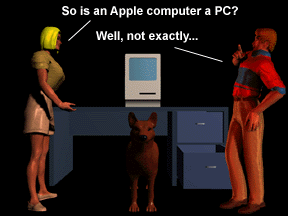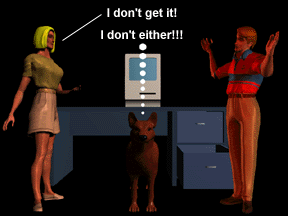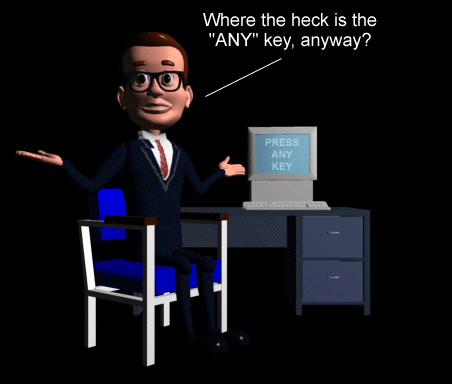A Close Look At Your Computer
In the Introduction to
Information Literacy, you learned how to use two tools to
get you through the lesson, the computer screen and the
computer mouse. In this lesson you will continue to use
these tools and to learn about the other parts of the
computer that make your search for and use of information
speedy and effective. The computer you are
working with has four important parts that you can see: the
screen and the mouse (that you have already met), and the
keyboard and a systems unit next to the screen or under it. Your
computer may or may not have two additional parts, a printer
and a modem. The computer you are
working with has four important parts that you can see: the
screen and the mouse (that you have already met), and the
keyboard and a systems unit next to the screen or under it. Your
computer may or may not have two additional parts, a printer
and a modem. Currently, there are two
major types of computers you are likely to encounter. These
two types are sometimes called platforms. One platform is
referred to as Apple or Macintosh and one platform is called
IBM or PC. The term PC is a little confusing. It stands for
Personal Computer. Computers made by the company Apple may
be called personal computers, but some people insist that if
you call it a PC, it has to be a computer that fits the IBM
platform. Regardless of your
platform, computers all have certain parts in common and
share certain principles about the way they work. These are
the important concepts that you will be learning about
computers: A good way to recognize
computer hardware is to think of it as the things about a
computer that you can get your hands on. At the beginning of
this lesson, you identified several parts of the computer
that make up visible computer hardware: the screen,
the mouse, the keyboard and the big box. You may also see a
printer and a modem. The computer mouse and
the keyboard are both hardware devices that allow you to
communicate with the computer. It is through these devices
that the computer can learn what your desires are. These two
devices are called input devices. The computer screen, or
the monitor, is the way that the computer communicates with
you. The computer monitor is also called an output
device. The printer is another output
device. You spent a little time
in the introduction learning how to use the input device,
the mouse. You learned that when you move the mouse on a pad
next to your computer, a white arrow/vertical black line on
the screen moves in correspondence. You also learned that
when you click the left mouse button when the arrow is
pointed to a particular area of the screen, you can control
what happens on the screen. In the introduction, you made
the screen scroll by pointing and clicking the mouse over a
triangle that is part of the image on the screen. By pointing and clicking
the mouse you can also place on the screen a point known as
the cursor.
The cursor
is the point on your
computer screen where your computer is ready for input. It
may appear as a still or flashing verticle or horizontal
line or as a box. When you type, information will be entered
at the point of the cursor. The computer keyboard
offers a range of special functions that are important to
master in order to use a computer best as a tool for
information literacy. In addition, some special function
computers you use will not have a mouse and will only allow
you to communicate with the computer through its keyboard.
Knowing how to touch-type will enable you to work quickly
when you use a computer. Knowing some keyboard basics are
essential for survival when using a computer. The diagram below
highlights important features of a computer
keyboard: Sometimes computer keys
work together to perform a pre-defined operation. It is
important when using these combinations of keys that you
press all of them at the same time. Stretch those
fingers! There will be times when
you are using a computer when the only way the computer will
register your message is if you hit the
enter
key after you
have typed in some information. This is true with database
or searching programs such as an electronic library catalog
or a search engine on the World Wide Web. Unlike a
typewriter, however, when you are using your computer for
word processing, you do not have to hit the enter key at the
end of a line. Word processors will automatically wrap the
typing around to the next line. Remember to hit the
space
bar in between
words. Many computer programs have a dictionary built into
them, but the computer does not automatically know where
words break. The tab
key will allow you to jump ahead a few spaces when your
computer is working as a word processor, or down or over to
another fill-in area when you are working with a
computerized form. The
shift
key allows you
to capitalize letters when you are using your computer as a
word processor. In addition, the shift key, as well as the
control
and the alt
key are keys that are often used in combination to perform
special functions with your computer. The top row of the
keyboard has keys called function
keys. These keys
are labelled with the letter F and the numbers
1-12. Before the Windows operating system became the
major operating system for personal computers, many computer
programs were written which assigned special capabilities to
the computer keyboard function keys. Some programs you use
may instruct you to use these keys. The
back
arrow key
located on the right side of the row of number keys allows
you to move the cursor to a position where you were
previously. Moving backward with this arrow key may or may
not erase the information that was previously typed there.
This depends on what software you are using. The
home
key will take
you to the beginning of a line on the screen and the
end
key will take
you to the end of a line. Page
Up and
Page
Down allow you
to move through complete screen in a single step. Remember
that when a file is brought onto a computer screen work or
presentation area, the file appears as though it is on a
single, long sheet of paper that is as long as the
information it holds requires it to be. The
arrow
keys also allow
you to move through your screen of material. The
insert
key allows you
to type over material you have already typed. The
delete
key allows you
to erase. The
print
screen key may
work alone or may work in combination with another key to
allow you to print what is on the screen. Using print
screen is a quick and dirty alternative to more elegant
ways of printing your files from any Windows
program. The
numeric
pad on the right
side of your keyboard allows you an alternative method of
using the computer keyboard numbers for calculation
purposes. The numeric pad numbers are labelled for multiple
functions. Remember when you are
using a computer these important communication, or input and
output points. Your computer will not know that you are
sending it messages unless you have used the mouse or the
keyboard; your computer may have the answer to your question
but you'll have to look at the screen to read it. The systems unit is the most
important piece of computer hardware. The systems unit has slot holes in the front where you
will be able to put information storage devices and buttons
to turn the computer on and off. In the back it has plug
holes where you can attach the other pieces of computer
hardware with wires. In addition to its
visible hardware, a computer has hidden
hardware, much of which is housed in the systems unit.
Hidden hardware are the parts of the computer that you can
get your hands on when you open up your systems
unit. One of the two most
important pieces of hidden hardware is the motherboard. On
the motherboard lives the CPU, or the central processing
unit. The CPU is a small component in the computer that is
capable of some very big functions. The CPU does the
calculations, runs the programs, controls what the computer
does, produces output and processes input. Another important piece
of hidden hardware is a hard drive, or a highly compacted
electronic storage device. Other important pieces of hidden
hardware that may be in your computer include electronic
curcuit boards, smaller than the motherboard, that enable
your computer to show video clips or offer sound. In
addition, if your computer has a modem, this may be hidden
in the computer. Your computer may also have a circuit board
that allows it to be part of a network (more on modems and
networks in the next chapter). One distinguishing
feature of personal computers as they have evolved during
the past decade is their capacity to store large quantities
of information in a small space. Computers store information
in units called bytes, or multiples of bytes such as
megabytes and gigabytes. The more bytes your computer has,
the more storage area it has. Computer storage is also
called memory. In addition to the hard
drive, the computer hardware storage device that stays in
your computer all the time, your computer can store
information on portable floppy disks (5 1/4" thin plastic
squares) and on CD-ROMs similar to your music CD's. The hard
drive, floppy disks and CD-ROMs are storage containers that
hold the information you need whether or not your computer
is on. They are like your clothes closets and drawers,
holding all your stuff for when you need it. Your computer has
another storage area in it called RAM, or random access
memory. RAM is housed on your computer's motherboard, along
with the CPU. RAM is only in use when your computer is on.
Any information you see on your computer screen is stored on
RAM. Any information your computer is currently working on
is stored in RAM. RAM is like the
chalkboard your teacher writes on in front of the classroom.
The information is available until the board is erased. If
you do not copy on to paper, a more permanent storage
device, the notes your teacher writes on the board, after
the board is erased, the information is gone. Remember that RAM is a
temporary sort of storage every time you are working at your
computer. Because you can see what you want while your
computer is turned on and the information in RAM is on the
screen, does not mean that the computer will retain this
information for you after you turn off the computer. As you
work with information on your computer, you will get used to
the idea of saving the work you have done so that
information that first enters the computer through RAM, will
be put into one of the permanent storage mediums already
described. Computer software is the
instructions, or programs, that give a computer the capacity
to perform different functions or applications. Software is
what allows you to type a paper for school (word processing
software), calculate a budget (spreadsheet software), search
an index for a collection of magazines (database software)
and play electronic chess (game software) all at the same
computer. A computer must be
loaded with the software you want to use in order for your
computer to be able to perform its specific functions. When
a computer is loaded with the software you want, the
software lives on a piece of the computer hardware -- either
on a floppy disk, a CD-ROM or on the hard drive when it is
not in use, or in RAM when that piece of software is
active. Two computers sitting
side-by-side in a classroom or an office may not be able to
do the exact same things. It all depends on what software is
loaded into each computer. Computer storage space decides
how many different pieces of software can be kept in a
single computer at one time. Take a look at a box of
computer software one day and read the label that says
"systems requirements." One of the requirements for running
a new piece of software is how much storage space (in RAM
and on your hard drive) is currently available on your
computer. If your computer is already loaded with a lot of
different pieces of software, you might not have room to add
a new piece of software. Software can be moved or
changed. However, because software is written to allow your
computer to perform certain functions, you probably will not
want to change the computer software or you will lose your
ability to do what you want with your computer. The operating system is
the software that allows people to communicate with the
computer hardware. The operating system of your computer
acts as a master controller regardless of what specific
function or functions your computer performs. The operating
system your computer uses is called Microsoft
Windows. Windows is the framework
you see on your computer screen, regardless of what
operation your computer is about to perform. Windows
provides a consistent, mouse-dependent approach to running
different types of applications software on your PC. Any
time you run a computer program using Windows, you will be
able to use the same techniques to perform the same type of
actions. In addition, Windows often gives you more than one
way of performing the same action. Two things that
distinguish Windows from the operating system that proceeded
it, DOS, are its ability to let you run more than one
program or perform more than one computer function at a time
(known as multi-tasking), and its preference for
mouse-clickable icons over typed-in commands. The opening screen in
Windows offers you pictures, or icons, with the names of
some of the programs loaded on to your computer and a
Start line at the bottom of the screen. When you
click the left mouse button on the word Start, a menu
box appears, offering you some options. The most important
option is the choice Programs. When you select
Programs, a complete list of the software programs
loaded in your computer appears in a second menu box. You
can click to select any of the programs you want to use from
the list of programs or you can click on the icon with the
name of the program you want. You can click on Start
again if you want to select another program as
well. The Start button
also allows you to find at random anything that is
loaded on your computer, run or install a new program
and shut down your computer. There are some useful
things to keep in mind when running a program with the
Windows operating system.
Lesson
Objectives
The
Lesson
The
Parts of Your Computer
 Visit
the Exploratory: Build a Computer System!
Visit
the Exploratory: Build a Computer System!




Computer
Hardware
Input
and Output
More on
Input: The Mouse
 Visit
the Exploratory: Run your mouse through a
maze!
Visit
the Exploratory: Run your mouse through a
maze!More on
Input: The Keyboard


 Visit
the Exploratory: Assemble a Keyboard!
Visit
the Exploratory: Assemble a Keyboard!Processing
Computer
Storage
 Visit
the Exploratory: Share Your Memories!
Visit
the Exploratory: Share Your Memories!
Computer
Software
 Visit
the Exploratory: Install Some Software!
Visit
the Exploratory: Install Some Software!Operating
Systems - Microsoft Windows
 Visit
the Exploratory: Try Out Microsoft Word!
Visit
the Exploratory: Try Out Microsoft Word!